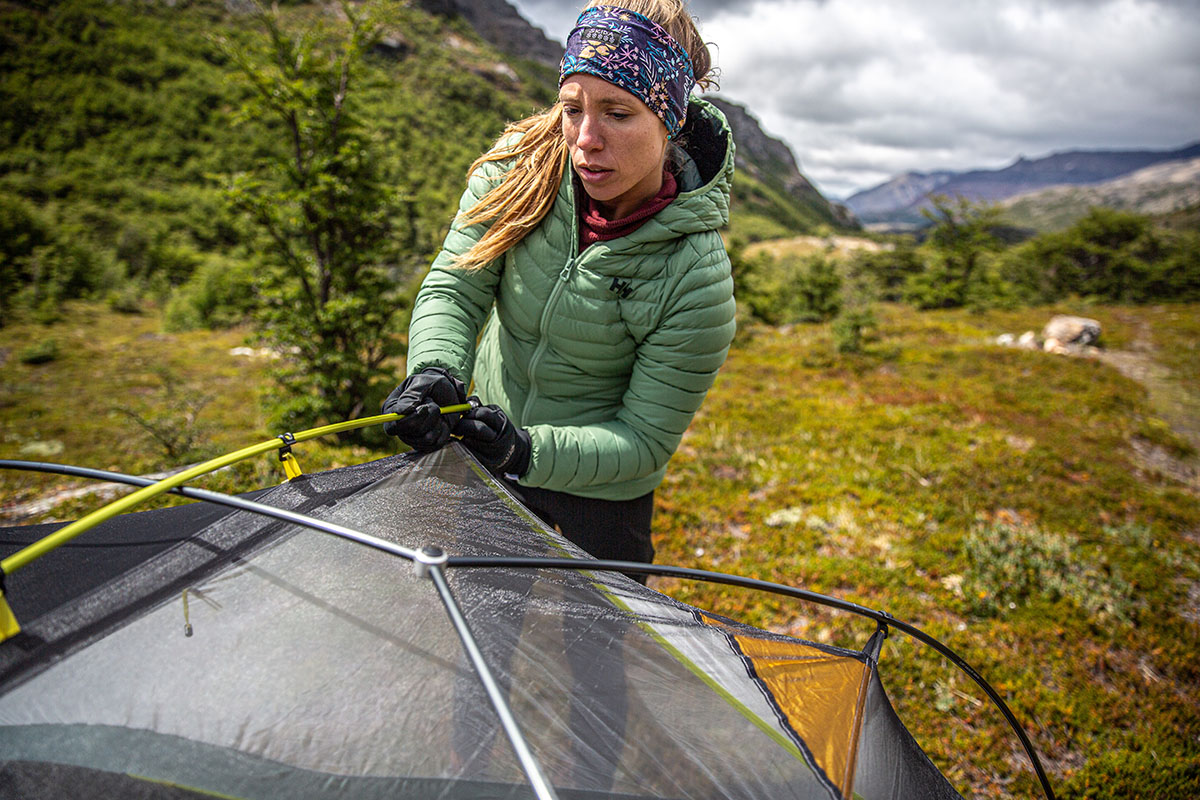
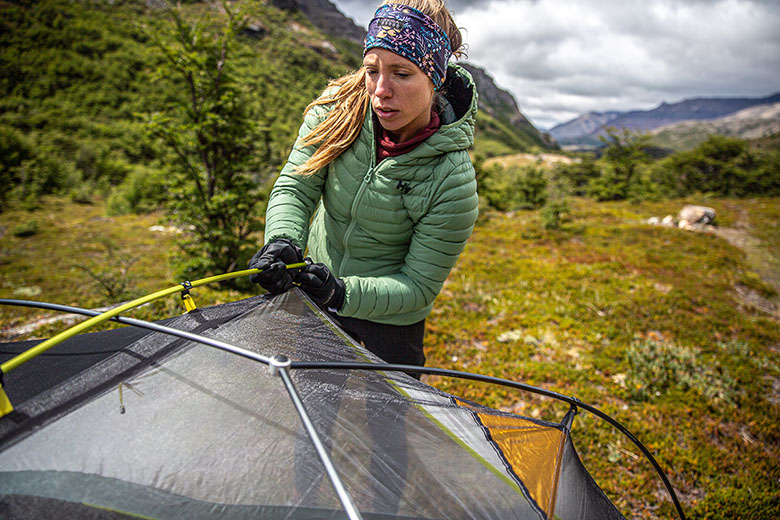
Price: $300
Weight: 11.3 ounces (women’s)
Fill: 700-fill-power down
What we like: Classy looks, flattering fit, and super soft and smooth feel.
What we don’t: Lower-quality down, hard to layer underneath, and prone to leaking feathers.
See the Women's Helly Hansen Verglas See the Men's Helly Hansen Verglas
Norway-based Helly Hansen doesn’t have a huge presence in the U.S., but their insulation and hardshell collections compete with the likes of Arc’teryx, Patagonia, and other leading outdoor brands. We recently brought their core down jacket, the Verglas, to southern Patagonia for testing, where it provided cozy warmth in unseasonably cool and wet conditions—and looked great in the process. That said, the mid-range down fill and propensity to leak feathers gave it a slightly less refined feel than the competition. Below I outline my experiences with the Verglas Hooded Down Insulator Jacket. To see how it stacks up to the competition, check out our articles on the best down jackets and best women’s down jackets.
The Helly Hansen Verglas Hooded Down Insulator is a lightweight down jacket built to handle typical shoulder-season and mild winter temperatures. For insulation, they opted for mid-range 700-fill down that isn’t as lofty or compressible as higher-fill-power designs like the Patagonia Down Sweater Hoody (800-fill) or Arc’teryx Cerium Hoody (850-fill), although it’s still decently warm for the weight. Helly Hansen doesn’t provide a fill weight (the actual amount of down inside the jacket), but the Verglas feels on par with most leading lightweight down sweaters, including the Patagonia mentioned above. Combined with the wind-resistant shell (more in “Weather Resistance” below), it kept me comfortable down into the low 40s Fahrenheit with just a light merino wool baselayer underneath, which is impressive considering how cold I run. Given my experiences while backpacking and hiking in the Verglas, I also expect it to be a great midlayer for skiing, although I haven’t had a chance to wear it on the slopes yet.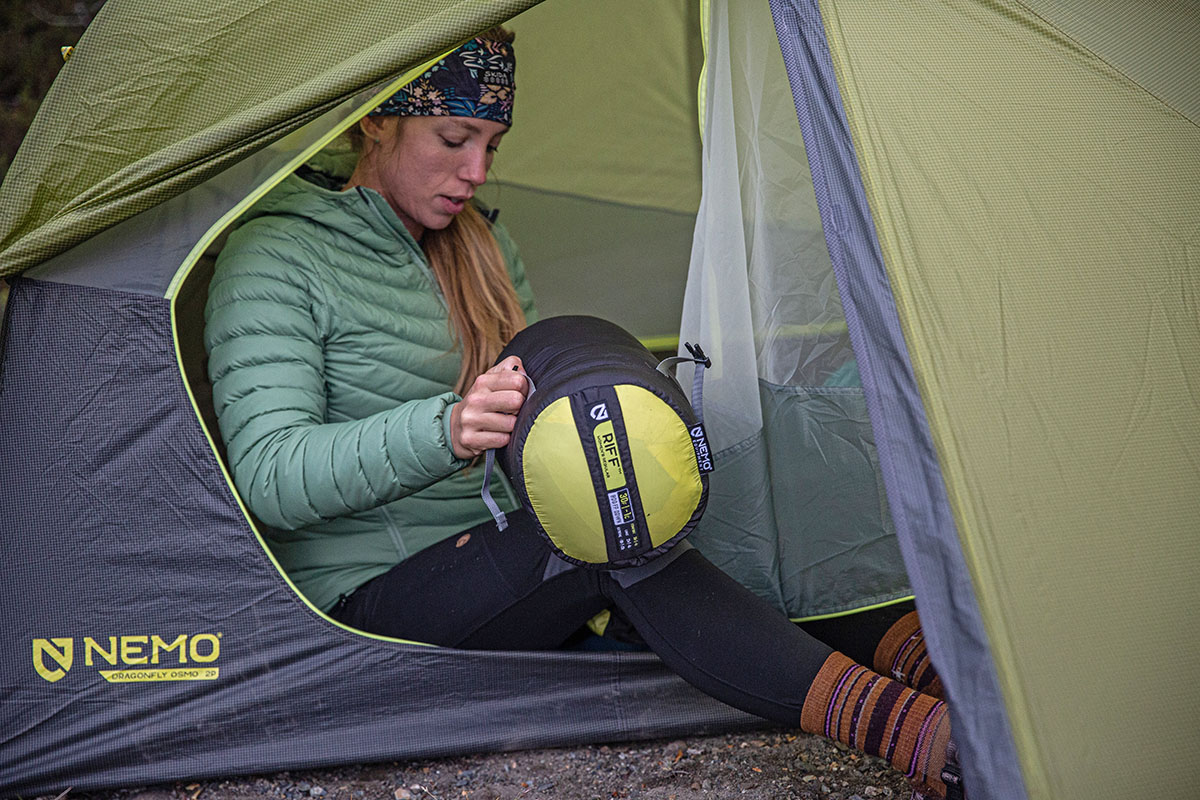
At 11.3 ounces for the women's hooded version (the non-hooded jacket is a little lighter at 10.9 oz.), the Helly Hansen Verglas is again competitive with most other down sweaters. For comparison, it’s around an ounce less than Patagonia’s uber-popular Down Sweater Hoody (12.1 oz.) while checking in a little heavier than more performance-oriented designs like Arc’teryx’s 10.2-ounce Cerium Hoody and Feathered Friends’ 10-ounce Eos. You can shave even more weight with a truly ultralight design like the Mountain Hardwear Ghost Whisperer/2 Hoody (7.8 oz.) or Montbell Superior Down Parka (7.3 oz.), but those pieces come with obvious sacrifices in durability and everyday appeal. In the end, the Verglas won’t be my first choice for throwing in a pack on future backcountry adventures—I’ll opt for my Ghost Whisperer instead—but it never felt like a burden in Patagonia and crossed over well for wearing around town, which I appreciated.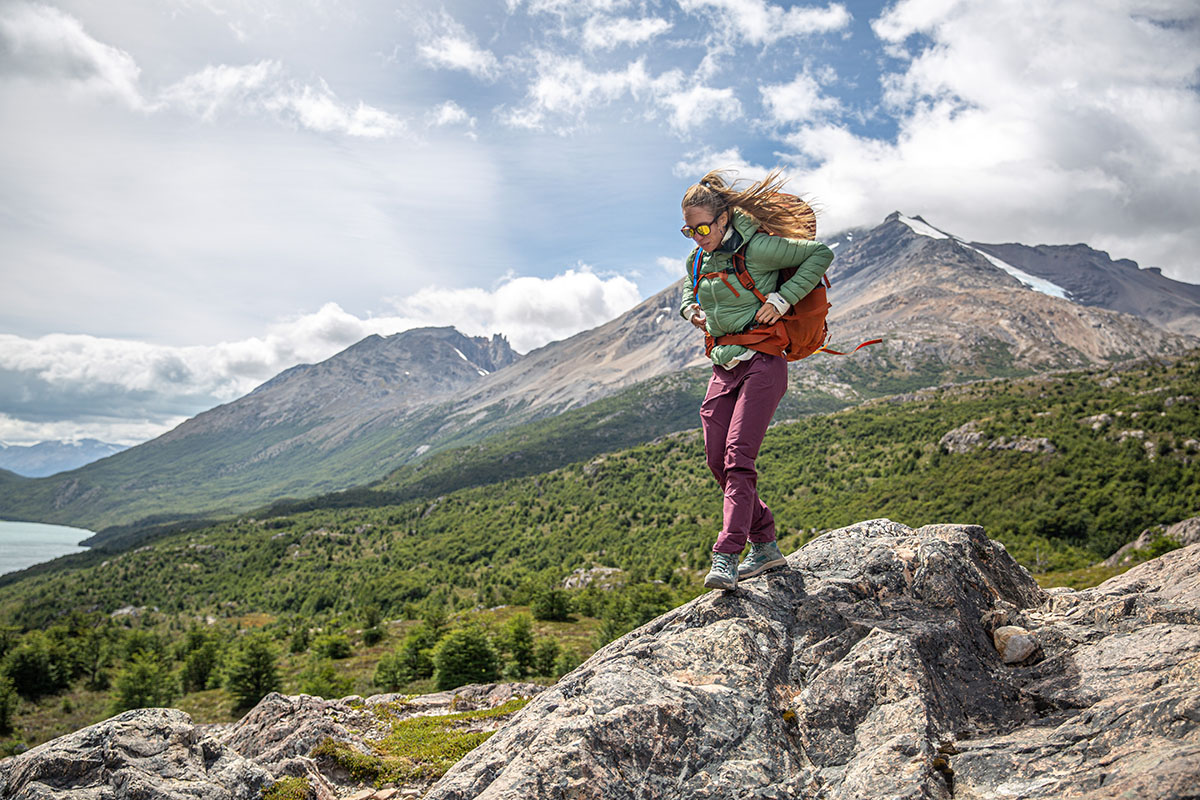
Packability almost always correlates closely with weight, and the Verglas sticks to that formula. When compressed into its left hand pocket, it’s about the size of an American football. I love when jackets pack into a pocket rather than a separate stuff sack (I've lost many of them over the years), although I often just compressed it into its hood to save time on the trail. Again, you can go smaller with ultralight designs like the Ghost Whisperer/2 or Superior Down Parka mentioned above, but the Verglas is perfectly serviceable for occasional backcountry use.
Down jackets are known to be poor performers in wet weather—unlike synthetic insulation, down clumps up and loses its insulating abilities when wet. Some designs include upgrades like waterproof panels or synthetic fill in moisture-prone areas for extra assurance in light to moderate snow or rainfall, but not the Verglas. You do get water-resistant YKK zippers for protecting items in the hand pockets, and the durable water repellent (DWR) coating on the jacket's exterior was effective at deflecting light moisture on our trip to Patagonia. The 20-denier (D) nylon ripstop shell also did a nice job of cutting the wind, and you get dual hem adjustments for sealing out drafts at the waist. All that said, the Verglas got overwhelmed quickly in the sustained rainfall on our final overnight, which wasn’t a big surprise. In anything more than a light drizzle, it’s worth throwing on a rain jacket or hardshell overtop.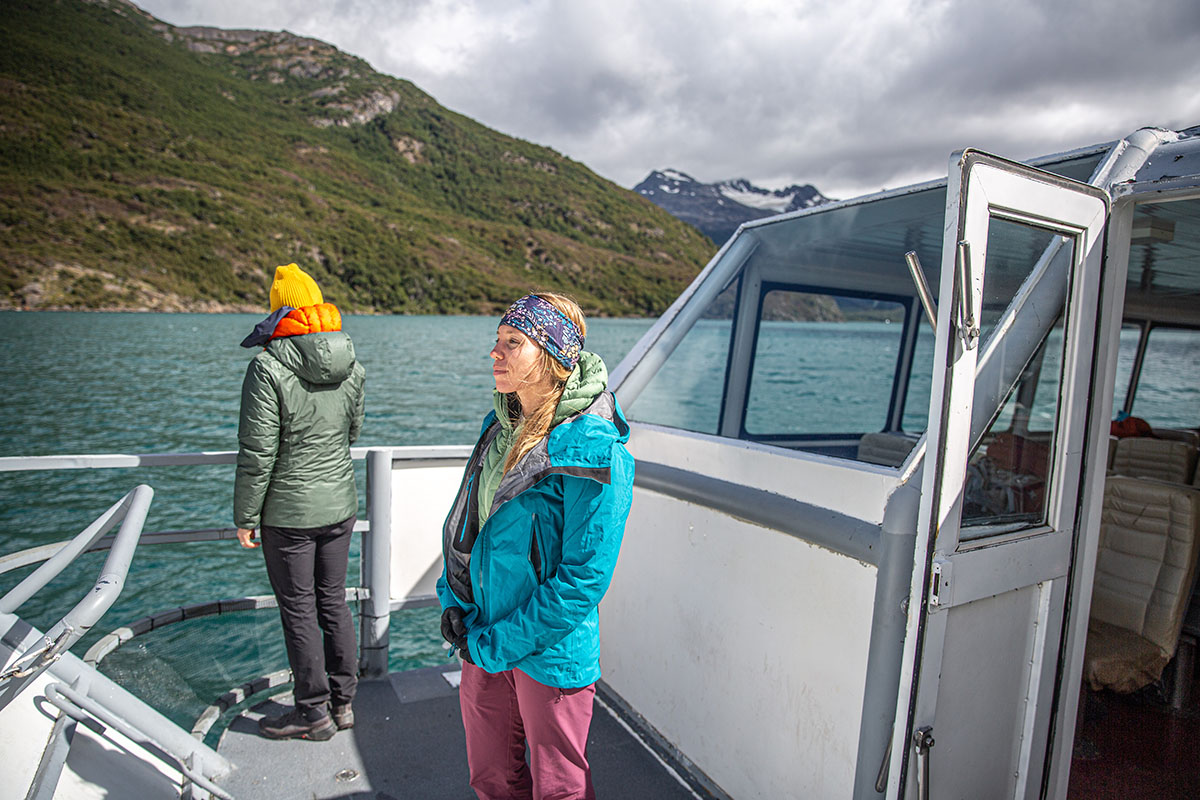
This was my first time wearing a Helly Hansen jacket, and I came away pleased by the Verglas’ overall quality. As I mentioned, the shell fabric is a reasonably hardwearing 20D nylon ripstop that did an admirable job of fending off snags and tears in the backcountry. I also stuffed the jacket haphazardly into my pack countless times without issue. Most of the smaller details are equally well sorted, including a robust main zipper that’s made of metal and easy to use with gloves on, a soft fleece patch along the chin, and a very smooth and supple feel inside and out. I also love the matte finish on the exterior, which adds a decidedly sleek and classy look compared to the glossy shells found on most down jackets. My only nitpick is that my Verglas began leaking feathers almost immediately, and there were several tiny pin holes with extruding feathers within the first few days of use. However, some shedding is to be expected with a new down jacket—the feathers take time to settle—so I’m not too concerned yet (I’ll report back after more use).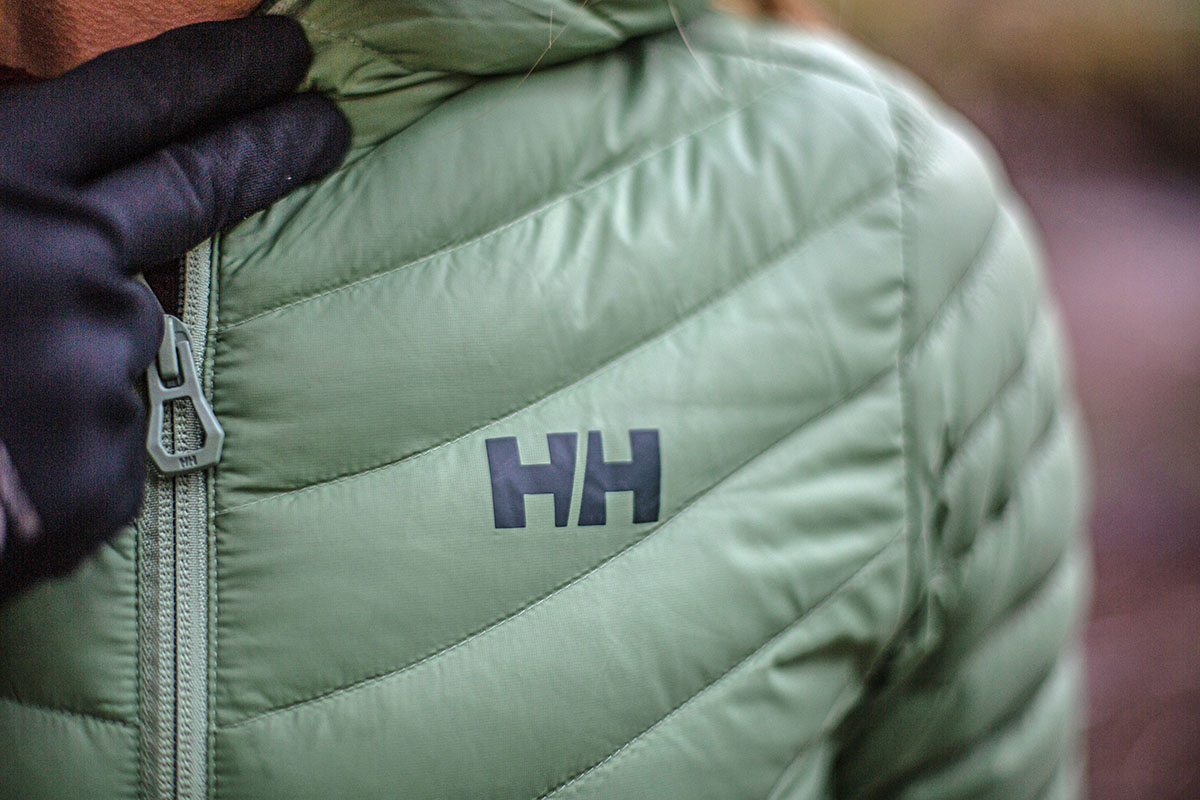
The Helly Hansen Verglas Hooded Down Insulator comes well equipped for everyday and light outdoors use. Starting with the hood, the design is fairly basic with no drawcord to cinch it tight, although the elastic around the perimeter did a decent job of keeping it in place, even in strong winds. It’s also not helmet-compatible—which isn’t surprising given the Verglas’ more casual intentions—but fits nicely on its own or over a beanie or baseball cap. It’s a similar story at the cuffs, where the slight elasticity provides a close fit without feeling restrictive (I was able to stretch them over thin gloves without issue). Rounding out the feature set, you get four total pockets: two hand pockets (the left doubles as the stuff sack), one inner chest pocket, and an interior dump pocket. I was happy to find that the chest pocket was big enough to fit my iPhone 13, and the dump pocket was great for stashing my beanie and liner gloves as temperatures shifted throughout our evenings at camp.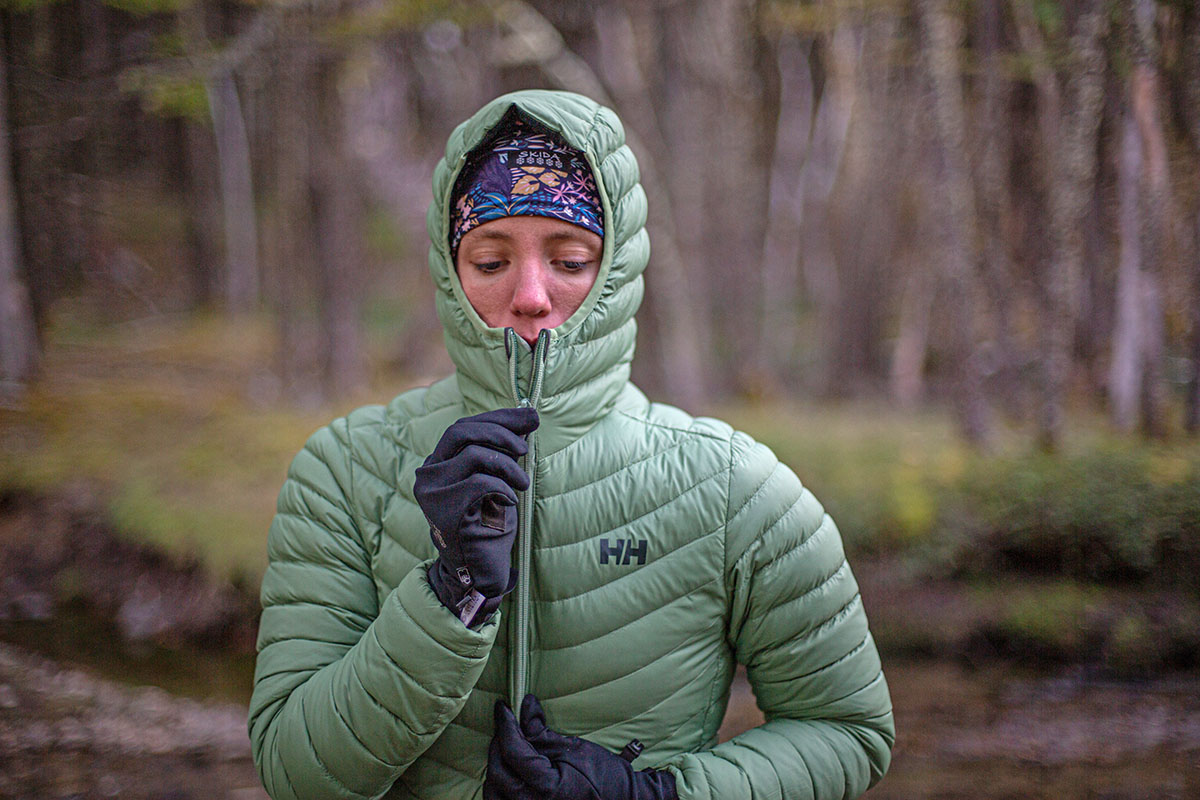
I ordered my usual size small in the women's Verglas Hooded Down Insulator Jacket and found it to be pretty trim all around (for reference, I’m 5’6 and around 135 lbs.). This was great for wearing with a pack and under a hardshell, but it did make it tough to layer underneath. On our trip to Patagonia, I was able to pair the Verglas with a lightweight wool baselayer and thin fleece midlayer on cool nights at camp, but anything more would have compromised mobility. If you’re on the fence or simply prefer a more accommodating fit, I recommend sizing up to be safe. For around-town wear, however, I love the tapered shape and body-hugging fit—it gives the Verglas a very classy, flattering look and feel. There’s also a slight drop hem for a bit of added coverage around back, which helped minimize riding up under my pack's hipbelt.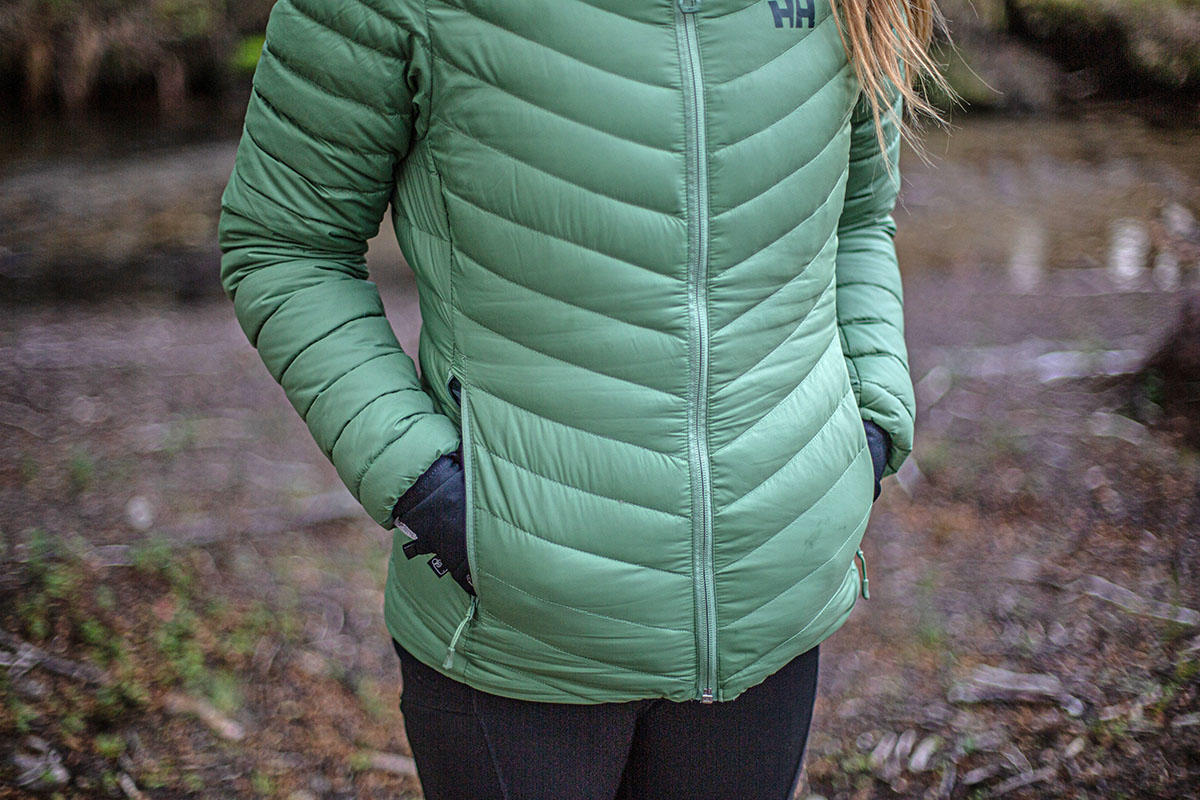
One way that outdoor brands are staying competitive in 2023 is by incorporating more sustainable production practices. In this case, Helly Hansen included a few key measures, starting with a PFC-free DWR coating that forgoes the use of harmful perfluorocarbons. The Verglas is also bluesign-approved, which indicates that all of the chemicals used are safe for workers, consumers, and the environment. Finally, the down insulation is certified to the Responsible Down Standard (RDS), which ensures that it’s been sourced humanely and responsibly. 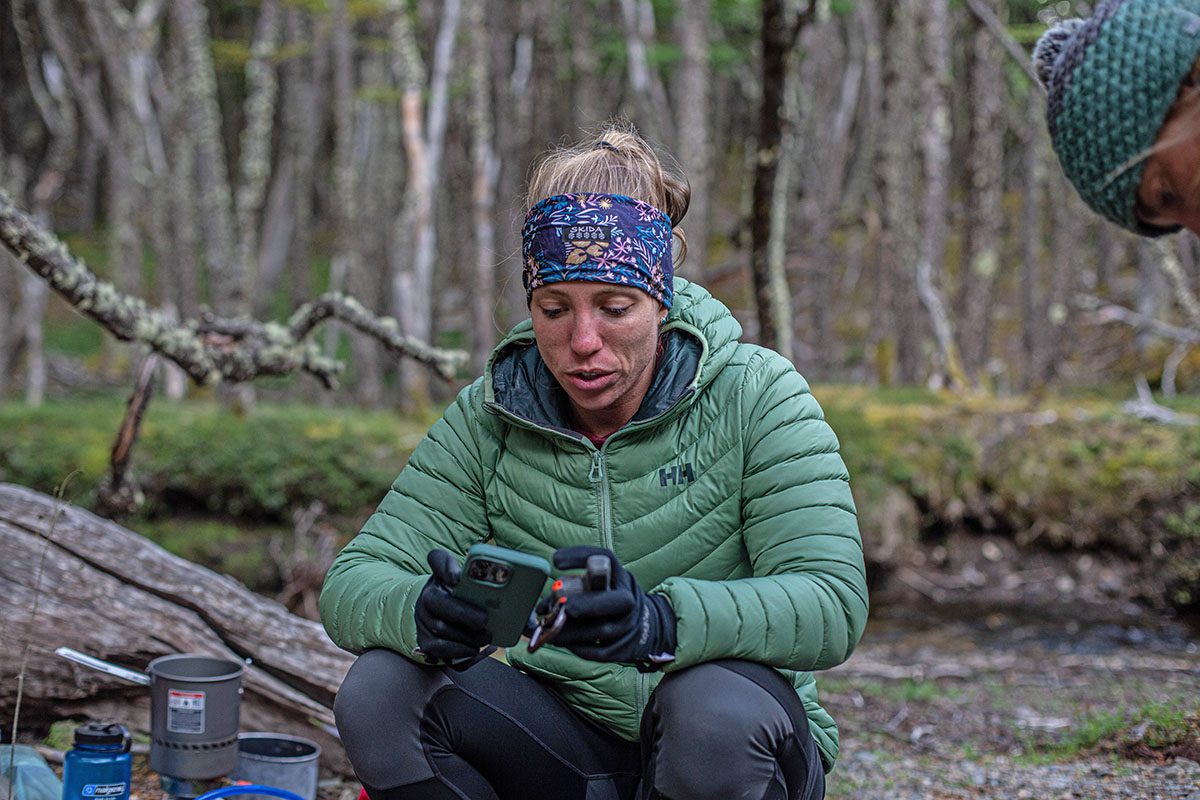
I tested the women’s Verglas Hooded Down Insulator Jacket for this review, and it also comes in a non-hooded version for $25 less. Apart from a 0.4-ounce drop in weight (for the women’s model), the two jackets are otherwise identical, including the same colorway selection. Both options are also sold in dedicated men’s versions, with the men’s Verglas Hooded Down Insulator Jacket checking in a little heavier than the women’s at 14 ounces. Other options include a parka-length variation for women; a hybrid design that uses a mix of down and synthetic insulation; and warmer Polar, Icefall, and Glacier models that have appeal for winter use.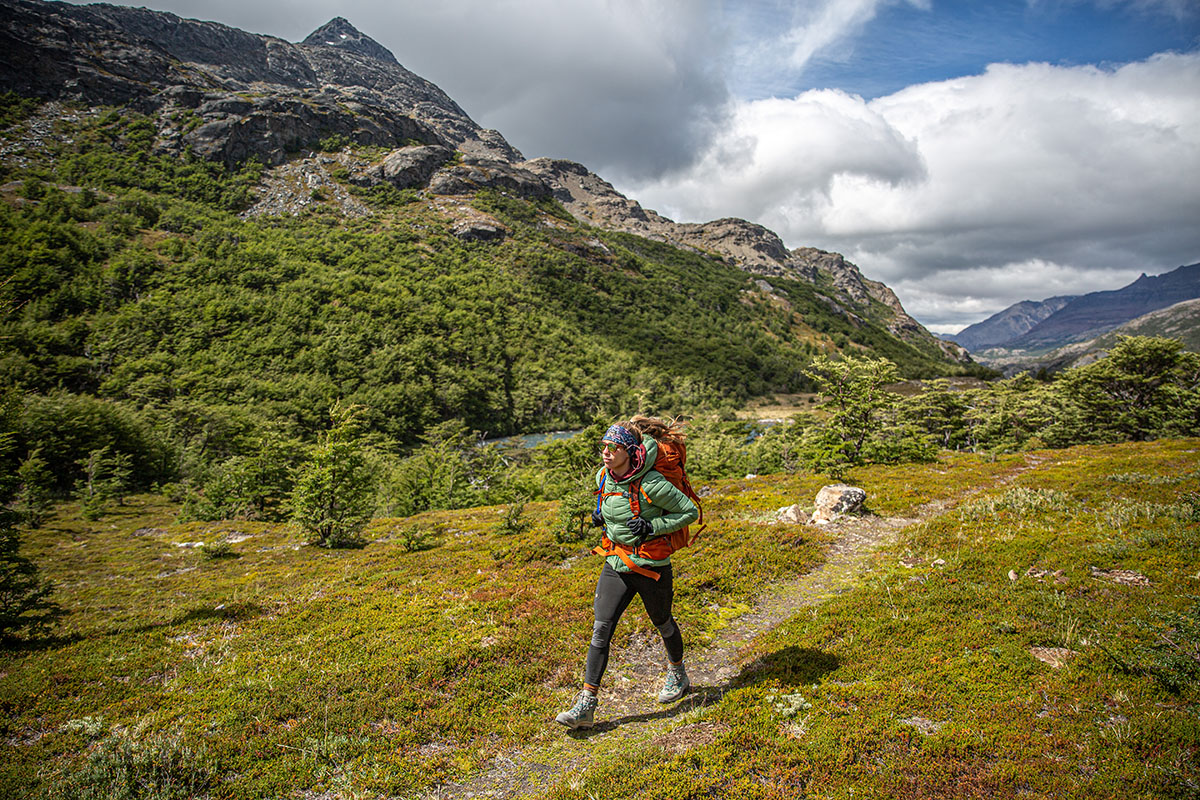
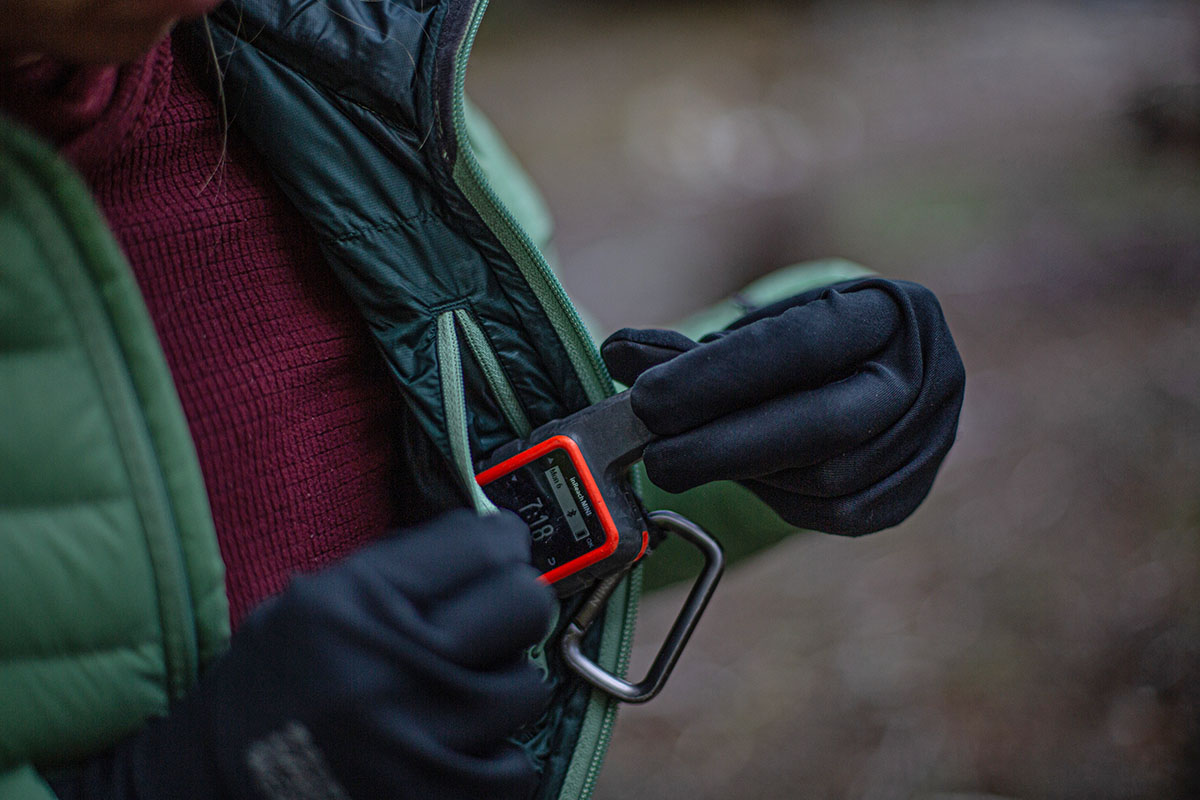
| Jacket | Price | Weight | Fill | Fill Weight | Denier |
|---|---|---|---|---|---|
| Helly Hansen Verglas | $300 | 11.3 oz. | 700-fill-power down | Unavail. | 20D |
| Patagonia Down Sweater Hoody | $329 | 12.1 oz. | 800-fill-power down | 4 oz. | 20D |
| Cotopaxi Fuego Down Jacket | $275 | 14 oz. | 800-fill-power down | Unavailable | 20D |
| Fjallraven Expedition Pack | $275 | 15.3 oz. | 700-fill-power down | 3.5 oz. | Unavail. |
| Arc'teryx Cerium Hoody | $400 | 10.2 oz. | 850-fill down & Coreloft | 3.3 oz. & 80/100g | 15D |
Helly Hansen’s Verglas Hooded Down Insulator Jacket is a comfortable and good-looking down jacket, but the competition is stiff in 2023. Our favorite design for years running has been Patagonia’s legendary Down Sweater Hoody, which features higher-quality 800-fill down that’s more compressible than the Verglas’ 700-fill variety, adjustability at the hood, and an additional dump pocket on the inside. We also prefer the Patagonia’s fit, which is trim enough to pair under a shell but with more room for layering underneath. The Down Sweater is a little heavier than the Helly Hansen at 12.1 ounces and will cost you around $30 more, but we consider those minor downsides for an otherwise exceptionally well-built and versatile design (for more, see our in-depth Down Sweater review).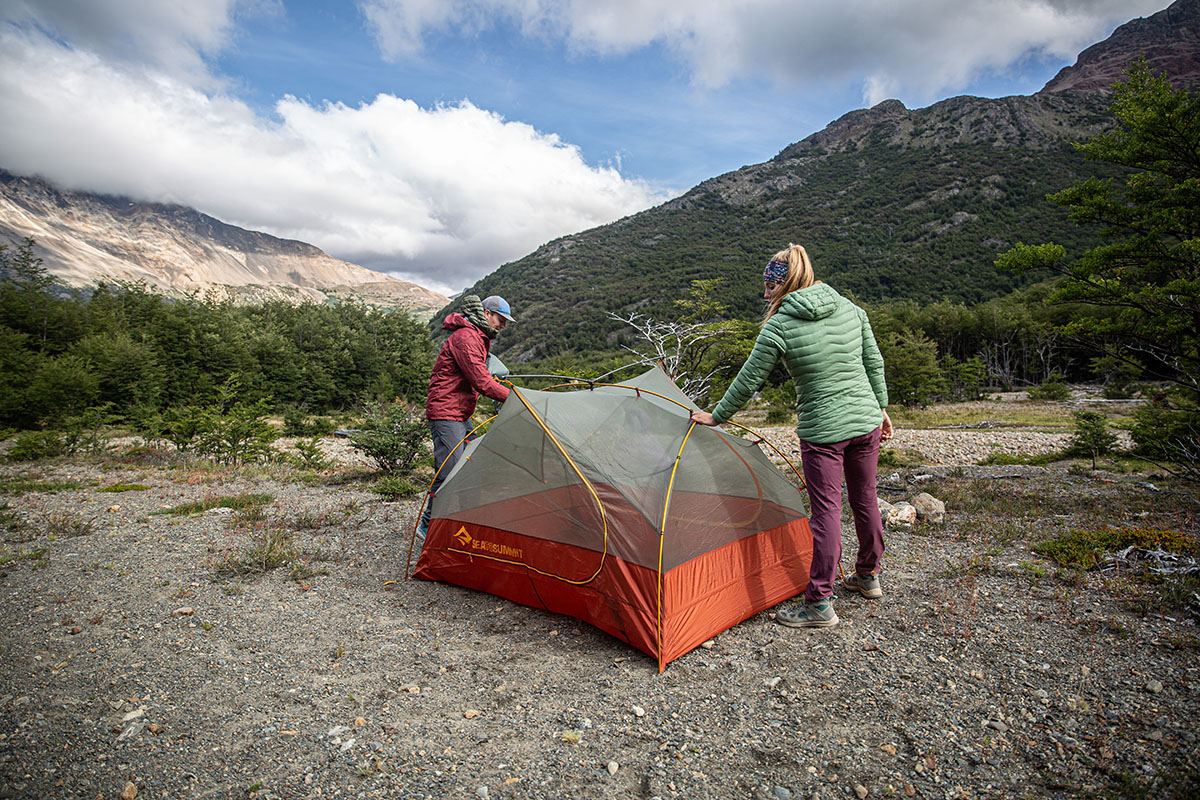
Cotopaxi’s Fuego Hooded Down Jacket is another leading down sweater and will save you $25 compared to the Verglas. Like the Patagonia mentioned above, the Fuego uses loftier and more premium 800-fill down, and we love the multi-toned colorways that give the jacket a distinctively retro look. With a recent update, the latest Fuego is now roomier than past versions and has a much more layering-friendly fit than the trim Verglas. However, weight jumps to 14 ounces, and the men’s version that we tested had a noticeably plasticky and slippery feel compared to the smooth and cozy Helly Hansen. In the end, both designs hit a nice balance of casual appeal and value, and a final decision will likely come down to preferences on looks and fit.
Next up is Fjallraven’s Expedition Pack Down Hoodie, which gives the Verglas a run for its money in terms of styling and versatility. Like the Helly Hansen, the Expedition uses mid-range 700-fill down for insulation and packs nicely into its own pocket. You also get synthetic fill over the shoulders for added protection against moisture, toggles at the back and sides of the hood for dialing in fit, and a two-way main zipper for added breathability and to minimize bunching up when sitting down (it’s also handy for belaying, although the Expedition wouldn’t be our first choice for this use). The Verglas does get the edge in weight by 4 ounces and tacks on an interior dump pocket, but the Fjallraven will save you $25 and wins out in most other areas. 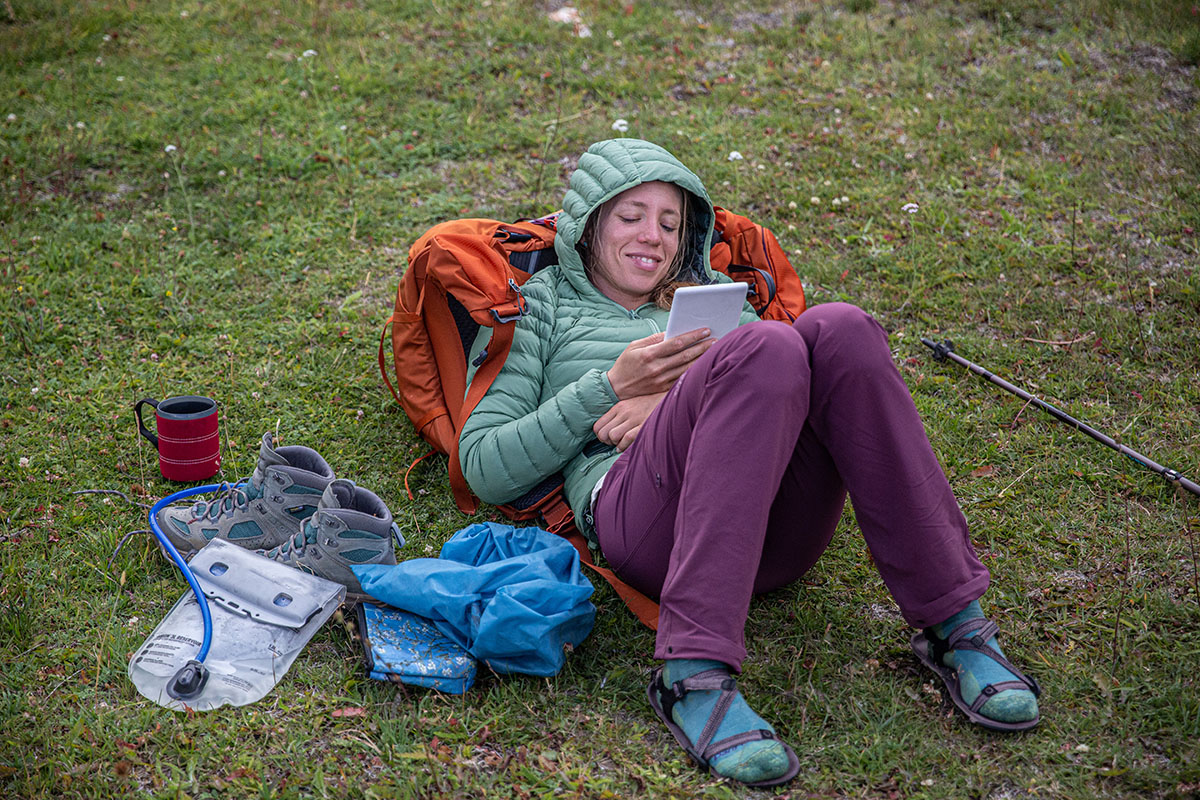
Last but not least is a more performance-focused alternative to consider: Arc’teryx’s Cerium Hoody. For $100 more than the Verglas, the Cerium uses higher-quality 850-fill down that’s warmer for the weight, checks in around an ounce lighter, and adds synthetic fill in moisture-prone areas for fending off light precipitation. We also love the StormHood design, which cinches evenly around the head with a single drawcord at the back. The Cerium’s shell fabric is a little thinner than the Verglas’ (15D vs. 20D) to keep weight low, and we don’t love the separate stuff sack for packing the jacket down (it’s easy to lose), but it’s one of the most well-built designs on the market and looks great around town, too. If you have some wiggle room in your budget, the Cerium won’t disappoint.